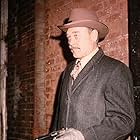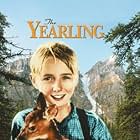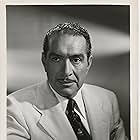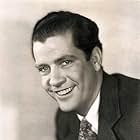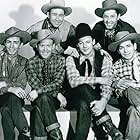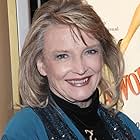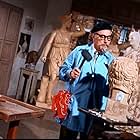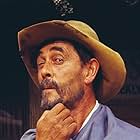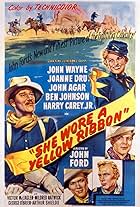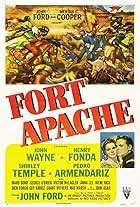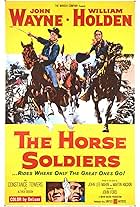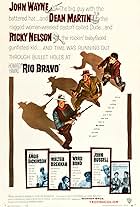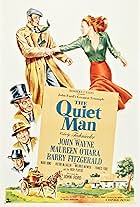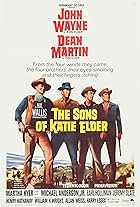A cavalry officer posted on the Rio Grande is confronted with murderous raiding Apaches, a son who's a risk-taking recruit and his wife from whom he has been separated for many years.A cavalry officer posted on the Rio Grande is confronted with murderous raiding Apaches, a son who's a risk-taking recruit and his wife from whom he has been separated for many years.A cavalry officer posted on the Rio Grande is confronted with murderous raiding Apaches, a son who's a risk-taking recruit and his wife from whom he has been separated for many years.
- Awards
- 1 nomination
Sons of the Pioneers
- Regimental Musicians
- (as Sons Of The Pioneers)
Ken Curtis
- Donnelly - Regimental Singer
- (uncredited)
Tommy Doss
- Regimental Singer
- (uncredited)
- Director
- Writers
- All cast & crew
- Production, box office & more at IMDbPro
Storyline
Did you know
- TriviaAccording to Maureen O'Hara in her autobiography, "Tis Herself", some stunt men died during the shooting of the film when they fell from their horses during a scene in the middle of a muddy river. Their bodies were allegedly never recovered.
- Goofs"You're in the Army Now" was written later (1917) than the time of the movie's actions.
- Quotes
[toasting]
Mrs. Kathleen York: To my only rival, the United States Cavalry.
- Alternate versionsAlso available in a computer colorized version.
- ConnectionsFeatured in Directed by John Ford (1971)
Featured review
"Rio Grande" was the last of John Ford's cavalry trilogy, which also included "She Wore a Yellow Ribbon" and "Fort Apache". Like the latter, this film was filmed in black and white. All three films were based on short stories by James Warner Bellah.
In this film John Wayne and Maureen O'Hara first played the romantic roles that they played later in films like "The Quiet Man" and "McLintock". There is real chemistry between these two stars. Their relationship is a major thread that weaves the plots and subplots of this film together. Both of their characters have depth. O'Hara is more than her usual fiery Irish self. She is sensitive, sometimes humorous and occasionally aristocratic. She has difficulty hiding her continued affection for her estranged husband Wayne despite the fact that he was responsible for burning the family plantation. Wayne is the tough commanding officer of the remote outpost. His toughness masks a softer side. This shows clearly when he stands outside the hospital window of his son, who has a black eye from a "soldier's fight". At the end of the film he takes a father's pride in his son's courage in battle.
There is more going on in the film than in the usual Western. There are relationships. Wayne is disappointed in his son who flunked at West Point and enlisted in the cavalry as a trooper. His mother wants to buy him out of the cavalry. The son wants to prove himself. All of this contributes to some real human moments in the film. Subplots include Trooper Tyree's sometimes humorous attempts to escape the law and the sometimes unwilling help provided by others. And of course there are the Apaches.
The river is a major theme in the movie. It is a barrier which the cavalry cannot cross in their pursuit of the Apaches. This is demonstrated in the opening credits. The cavalry and Mexican soldiers meet at the river in a scene from later in the movie. When captured chiefs escape across the river Wayne meets a Mexican officer in the middle of the stream. He offers to place himself under Mexican command. The Mexican officer declines, saying he must defend the border "at all costs". Wayne responds, "With three men.. .Your dedication to duty is to be commended. I too have my orders." At the end of the film Wayne risks his career with the complicity of General Sheridan (played by J. Carroll Naish) and crosses the river to rescue the children captured by the Apaches.
The supporting cast does a wonderful job with this film. Many are regular faces in John Ford films. Ben Johnson and Harry Carey, Jr. play friends of Wayne's son (played by Claude Jarman, Jr.). Victor McLaglen plays the role of top Sergeant. He played the same role in all three films in Ford's trilogy. Chill Wills is around and is much better than usual as the doctor who helps Trooper Tyree escape from a Texas sheriff. The Sons of the Pioneers are also on hand to sing songs.
The Victor Young score includes elements which will appear later in the "Quiet Man". Many of the songs are dumb and inappropriate. There are too many Irish ballads that would have been much better used in "The Quiet Man". The few songs by Stan Jones are the best of the lot. At one point in the film the cavalrymen are walking their horses to the lyrics "twenty-four miles on beans and hay".
Photographically this film is less impressive than "She Wore A Yellow Ribbon", but the usual shots of Monument Valley are still impressive. There is an appropriate dark quality to this movie that is missing in the other films in the trilogy, even in "Fort Apache", which was also filmed in black and white. The scene at the deserted church is memorable. The black and white photography accentuates the shadows and the threat of death to the children as the Apaches dance the night away.
This film is based on a historical incident. In 1874 Colonel McKenzie led the 5th Cavalry across the Rio Grande to destroy a Kickapoo village in Mexico. The Kickapoos had been raiding quite successfully in Texas and efforts to punish them had been quite fruitless. This forgotten incident was used by Ford in this film. The Indians now are Apaches, but whoever heard of Kickapoos?
This fine Western is worth seeing for its rich characterizations and fine story. It can be enjoyed on many levels.
In this film John Wayne and Maureen O'Hara first played the romantic roles that they played later in films like "The Quiet Man" and "McLintock". There is real chemistry between these two stars. Their relationship is a major thread that weaves the plots and subplots of this film together. Both of their characters have depth. O'Hara is more than her usual fiery Irish self. She is sensitive, sometimes humorous and occasionally aristocratic. She has difficulty hiding her continued affection for her estranged husband Wayne despite the fact that he was responsible for burning the family plantation. Wayne is the tough commanding officer of the remote outpost. His toughness masks a softer side. This shows clearly when he stands outside the hospital window of his son, who has a black eye from a "soldier's fight". At the end of the film he takes a father's pride in his son's courage in battle.
There is more going on in the film than in the usual Western. There are relationships. Wayne is disappointed in his son who flunked at West Point and enlisted in the cavalry as a trooper. His mother wants to buy him out of the cavalry. The son wants to prove himself. All of this contributes to some real human moments in the film. Subplots include Trooper Tyree's sometimes humorous attempts to escape the law and the sometimes unwilling help provided by others. And of course there are the Apaches.
The river is a major theme in the movie. It is a barrier which the cavalry cannot cross in their pursuit of the Apaches. This is demonstrated in the opening credits. The cavalry and Mexican soldiers meet at the river in a scene from later in the movie. When captured chiefs escape across the river Wayne meets a Mexican officer in the middle of the stream. He offers to place himself under Mexican command. The Mexican officer declines, saying he must defend the border "at all costs". Wayne responds, "With three men.. .Your dedication to duty is to be commended. I too have my orders." At the end of the film Wayne risks his career with the complicity of General Sheridan (played by J. Carroll Naish) and crosses the river to rescue the children captured by the Apaches.
The supporting cast does a wonderful job with this film. Many are regular faces in John Ford films. Ben Johnson and Harry Carey, Jr. play friends of Wayne's son (played by Claude Jarman, Jr.). Victor McLaglen plays the role of top Sergeant. He played the same role in all three films in Ford's trilogy. Chill Wills is around and is much better than usual as the doctor who helps Trooper Tyree escape from a Texas sheriff. The Sons of the Pioneers are also on hand to sing songs.
The Victor Young score includes elements which will appear later in the "Quiet Man". Many of the songs are dumb and inappropriate. There are too many Irish ballads that would have been much better used in "The Quiet Man". The few songs by Stan Jones are the best of the lot. At one point in the film the cavalrymen are walking their horses to the lyrics "twenty-four miles on beans and hay".
Photographically this film is less impressive than "She Wore A Yellow Ribbon", but the usual shots of Monument Valley are still impressive. There is an appropriate dark quality to this movie that is missing in the other films in the trilogy, even in "Fort Apache", which was also filmed in black and white. The scene at the deserted church is memorable. The black and white photography accentuates the shadows and the threat of death to the children as the Apaches dance the night away.
This film is based on a historical incident. In 1874 Colonel McKenzie led the 5th Cavalry across the Rio Grande to destroy a Kickapoo village in Mexico. The Kickapoos had been raiding quite successfully in Texas and efforts to punish them had been quite fruitless. This forgotten incident was used by Ford in this film. The Indians now are Apaches, but whoever heard of Kickapoos?
This fine Western is worth seeing for its rich characterizations and fine story. It can be enjoyed on many levels.
- How long is Rio Grande?Powered by Alexa
Details
Box office
- Budget
- $1,214,899 (estimated)
- Runtime1 hour 45 minutes
- Color
- Aspect ratio
- 1.37 : 1
Contribute to this page
Suggest an edit or add missing content















